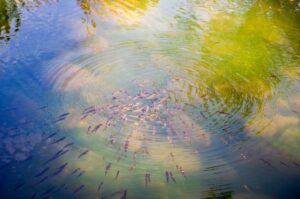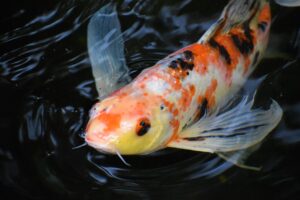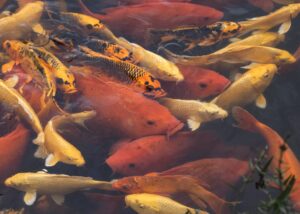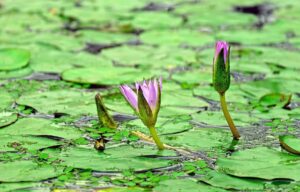People always ask is it hard to maintain a Fish pond, and without a doubt it always seems like a daunting task at first, but rest assured, it’s not as challenging as it may seem.
Whether you’re an experienced fish enthusiast or a beginner looking to start your own fish paradise, keeping a fish pond can be a rewarding and enjoyable experience. In this article, we will explore the key aspects of maintaining a fish pond and provide you with practical tips and advice to make the process a breeze.
So, if you’ve ever wondered about the challenges of maintaining a fish pond, read on to discover how you can create a thriving aquatic habitat right in your own backyard.
Choosing the Right Location for Your Fish Pond
Consider the Amount of Sunlight
When choosing a location for your fish pond, it’s important to consider the amount of sunlight the area receives. Most fish require sunlight to thrive, as it helps promote the growth of beneficial aquatic plants and algae that serve as a natural food source. Therefore, selecting a spot that receives at least 6 hours of direct sunlight each day is ideal. This will ensure that your fish have enough access to sunlight for their health and well-being.
Ensure Access to a Water Source
Another crucial factor to consider when choosing a location for your fish pond is access to a water source. Your pond will need a constant supply of fresh water to maintain proper water quality and oxygen levels. It’s advisable to select a location that is near a water source, such as a hose or outdoor faucet, to make water changes and additions more convenient. This will also reduce the need for long hoses or buckets to transport water to your pond.
Avoid Low-Lying Areas
When deciding on a location for your fish pond, it’s best to avoid low-lying areas. Low-lying areas are prone to flooding, especially during heavy rain or snow melts, which can lead to the overflow of your pond and potential damage to your property. Additionally, these areas tend to accumulate runoff water that may contain pollutants, which can negatively impact the water quality and overall health of your fish. Therefore, selecting a location that is on higher ground will help prevent these problems and ensure a more stable environment for your fish.
Check for Potential Hazards
Before finalizing the location for your fish pond, it’s essential to check for potential hazards in the area. Look out for trees with overhanging branches that may drop leaves or debris into the pond, as this can cause water quality issues. Additionally, be cautious of nearby structures or buildings that may create shading and disrupt the sunlight exposure to your pond. It’s also crucial to consider the proximity to power lines to avoid any interference or safety hazards. Taking these precautions will help create a safe and suitable environment for your fish pond.

Designing and Constructing the Fish Pond
Decide on the Size and Shape
When designing your fish pond, it’s important to decide on the size and shape that best suits your needs and available space. Consider the type and number of fish you plan to keep and ensure the pond is large enough to accommodate their growth. A rule of thumb is to have at least 10 gallons of water per inch of fish length. As for the shape, there are various options such as circular, oval, rectangular, or freeform. Choose a shape that complements your landscape and provides visual appeal.
Research the Ideal Depth
The ideal depth of your fish pond will depend on the specific fish species you plan to keep. Different fish have different requirements, with some needing deeper water for spawning or hibernation. Research the specific needs of the fish species you wish to introduce and design your pond accordingly. Generally, a depth of at least 2 to 3 feet is recommended for most common pond fish. This depth will provide enough space for the fish to swim and escape extreme temperature variations.
Select a Suitable Liner
Choosing the right liner for your fish pond is crucial for its long-term success. The liner helps prevent water from seeping into the surrounding soil and ensures proper containment. There are different types of liners available, including PVC, EPDM rubber, and concrete. Each has its advantages and considerations, such as cost, durability, and ease of installation. Research the pros and cons of each type and select a liner that fits your budget and meets the specific requirements of your fish pond.
Install a Filtration System
Installing a filtration system is essential for maintaining water quality in your fish pond. The filtration system helps remove debris, excess nutrients, and harmful substances, ensuring a healthy environment for your fish. There are different types of filtration systems available, including mechanical, biological, and chemical filters. Additionally, consider incorporating a skimmer to remove floating debris and a UV sterilizer to control algae growth. The right combination of filtration components will help keep your pond water clear and balanced.

Introducing Fish and Other Aquatic Life
Research Different Fish Species
Before introducing fish to your pond, it’s crucial to research different fish species and choose those that are well-suited to your pond’s conditions. Consider factors such as water temperature, pH level, and compatibility with other fish species. Some popular choices for fish ponds include goldfish, koi, and various species of freshwater fish. Learn about their specific requirements, such as feeding habits, growth size, and behavior, to ensure you provide them with the best possible environment.
Consider Compatibility of Fish
When selecting fish for your pond, it’s important to consider their compatibility with each other. Some fish species may be territorial or aggressive, which can lead to stress, injury, or even death. Consult with experts or your local fish supplier to determine which fish species can coexist peacefully. Additionally, consider the size and growth potential of the fish, as overcrowding can lead to health issues and poor water quality. By carefully choosing compatible fish, you’ll ensure a harmonious and thriving pond ecosystem.
Acclimate Fish to the New Pond
Once you’ve chosen your fish species, it’s crucial to acclimate them properly to their new pond environment. This process helps reduce stress and improves their chances of survival. Before releasing the fish into the pond, float their bag or container on the water surface for about 15-20 minutes to allow the temperature to equalize. Then, slowly add small amounts of pond water to the bag or container over the course of an hour. Finally, gently release the fish into the pond, avoiding sudden movements or disturbances.
Include Plants and Other Aquatic Life
To enhance the overall health and beauty of your fish pond, consider including aquatic plants and other aquatic life. Plants provide natural shade, oxygenate the water, and help in nutrient absorption. Choose a variety of submerged, floating, and marginal plants to create a balanced ecosystem and provide habitats for fish and other aquatic creatures. Additionally, consider introducing snails, tadpoles, or other small animals that can contribute to the pond’s ecosystem and help control algae growth.

Maintaining Water Quality and Oxygen Levels
Regularly Test Water Parameters
To ensure the well-being of your fish, it’s important to regularly test the water parameters of your pond. Test for essential parameters such as pH, ammonia, nitrite, nitrate, and oxygen levels. This will help you identify any imbalances or potential issues early on. Monitoring and maintaining appropriate water parameters will promote optimal fish health, support beneficial bacteria growth, and prevent harmful conditions that can lead to diseases or fish stress.
Monitor and Control Algae Growth
Algae growth is a common issue in fish ponds and can negatively impact water quality. Excessive algae can deplete oxygen levels, reduce visibility, and create unsightly green or murky water. To control algae growth, it’s essential to monitor nutrient levels, limit sunlight exposure through shading or floating plants, and consider the use of natural remedies such as barley straw or beneficial bacteria additives. Regular cleaning and maintenance, such as removing excess debris and preventing overfeeding, can also help control algae growth.
Remove Debris and Dead Plant Matter
Regularly removing debris and dead plant matter from your fish pond is crucial to maintaining good water quality. Decomposing organic matter can release harmful compounds and contribute to poor water conditions. Use a net or skimmer to scoop out leaves, twigs, and other debris that accumulate on the water surface. Additionally, trim and remove any dying or dead plant material to prevent it from decaying and impacting water quality. By keeping your pond clean, you’ll create a healthier environment for your fish.
Properly Aerate the Pond
Maintaining adequate oxygen levels in your fish pond is vital for the health and well-being of your fish. Proper aeration helps ensure oxygen is distributed evenly throughout the water and prevents stagnation. Consider installing a fountain, waterfall, or air pump to promote oxygen exchange and circulation. This will also help prevent the buildup of harmful gases, such as carbon dioxide, and reduce the risk of oxygen depletion during warmer months or periods of high fish activity.

Feeding and Caring for the Fish
Determine Optimal Fish Diet
Proper nutrition is essential for the growth and overall health of your fish. Different fish species have varying dietary requirements, so it’s important to determine the optimal diet for your specific fish. Research the nutritional needs of the fish species you keep and provide a balanced diet that includes commercial fish food, live or frozen foods, and occasional treats such as vegetables or fruits. Avoid overfeeding, as excess food can lead to poor water quality and health issues for your fish.
Feed Fish Appropriately and Regularly
Establishing a regular feeding schedule is important for maintaining the health of your fish. Feed your fish small amounts of food multiple times a day, taking care not to overfeed. Avoid throwing large quantities of food into the pond at once, as uneaten food will sink to the bottom and contribute to nutrient buildup. Observe your fish while feeding to ensure that all individuals in the pond have an opportunity to eat and adjust the feeding amount as necessary.
Monitor Fish Health
Regularly monitoring the health of your fish is essential for detecting any potential issues early on. Observe your fish for any signs of stress, disease, or abnormal behavior. Look out for changes in appetite, coloration, swimming patterns, or physical abnormalities. Healthy fish should be active, have clear and bright eyes, show vibrant coloration, and have intact fins and scales. By being attentive and proactive, you can address any health concerns promptly and minimize the impact on your fish population.
Address any Health Issues Promptly
If you notice any signs of illness or poor fish health, it’s crucial to address the issue promptly. Isolate and quarantine any sick or injured fish to prevent the spread of disease within the pond. Research common fish diseases and consult with a veterinarian or fish expert to accurately diagnose the problem and determine the appropriate treatment. Follow any recommended treatment protocols and adjustments to water parameters to ensure a successful recovery for your fish.

Managing Water Temperature and Seasonal Changes
Use Heaters or Shade Cloth as Needed
Maintaining stable water temperatures is important for fish health, especially during extreme weather conditions. During hot summer months, consider using shade cloth or aquatic plants to provide shade and prevent excessive heating of the pond water. In colder climates or during winter, use heaters or de-icers to prevent freezing and create a temperature range suitable for your fish. Monitoring and regulating water temperature will help minimize stress and prevent temperature-related health issues.
Prepare for Winter and Freezing Conditions
Winter can pose unique challenges for maintaining a fish pond, particularly in regions with freezing temperatures. Before winter arrives, make necessary preparations to protect your fish and pond. Consider installing a pond heater or aerator to prevent complete freezing and create an area with sufficient oxygen for the fish to survive. Remove any delicate plants or move them to a more protected location. Additionally, cover the pond with a net or mesh to prevent leaves, debris, or predators from entering.
Monitor Water Temperature Regularly
Throughout the year, it’s important to regularly monitor the water temperature in your fish pond. Use a thermometer to check the temperature and take note of any significant changes. Sudden temperature variations can stress your fish and compromise their immune system, making them more susceptible to diseases. By staying vigilant and aware of the water temperature, you can make adjustments to ensure the optimal conditions for your fish’s well-being.
Provide Shelter for Fish during Extreme Weather
During extreme weather conditions, such as severe storms or intense heatwaves, it’s crucial to provide shelter for your fish. Having hiding spots, such as rocks, caves, or dense aquatic plants, will give your fish a safe place to retreat to when faced with stressful situations. These shelters not only protect them from harsh weather but also provide a sense of security and reduce their vulnerability to predators. Creating a safe and secure environment will contribute to the overall health and happiness of your fish.

Preventing and Managing Fish Diseases
Maintain Good Water Quality
Maintaining good water quality is the first line of defense in preventing fish diseases. Clean and clear water helps reduce stress and minimizes the risk of infections or parasites. Follow the recommended guidelines for water testing and parameter maintenance mentioned previously in this article. Regularly monitor and address any imbalances promptly. By maintaining excellent water quality, you create a resilient and healthy environment that promotes fish well-being and reduces the likelihood of diseases.
Quarantine New Fish
Introducing new fish to your pond can potentially introduce diseases or parasites. To minimize this risk, it’s advisable to quarantine new fish before adding them to the main pond population. Set up a separate quarantine tank or pond with its own filtration system. Keep the new fish isolated for a minimum of two weeks and observe them for any signs of illness. This will help ensure that any potential diseases or infections are detected and treated before introducing the fish to the main pond.
Identify and Treat Diseases Early
Regular monitoring and observation are crucial for early detection of fish diseases. Familiarize yourself with common fish diseases and their symptoms, such as abnormal behavior, discoloration, ulceration, or fin deterioration. If you notice any signs of illness, take immediate action. Consult a veterinarian or fish expert to accurately diagnose the disease and determine the appropriate treatment. Prompt treatment increases the chances of a successful recovery and minimizes the impact on your fish population.
Consult a Vet or Fish Expert if Needed
If you encounter any fish health issues that you are unsure how to address or if a situation worsens despite your efforts, it’s essential to seek professional advice. Consult a veterinarian with expertise in aquatic animals or reach out to a fish expert for guidance and assistance. They can provide you with expert insights, personalized recommendations, and appropriate medications if necessary. Remember, seeking professional help can make a significant difference in the health and well-being of your fish.
Controlling Pests and Predators
Install Netting to Protect Fish
To protect your fish from predators such as birds or small mammals, it’s advisable to install netting over your pond. Netting acts as a physical barrier, preventing predators from accessing your fish. Choose a net with small enough holes to prevent birds or other animals from reaching through and ensure that the netting is securely fastened to avoid gaps or loose areas. Regularly check the netting for any tears or damage and repair them promptly to maintain the effectiveness of the barrier.
Use Safe and Effective Pest Control Methods
In addition to netting, you may encounter certain pests that pose a threat to your fish. Algae-eating snails or certain insect larvae can become invasive and disrupt the balance of your pond ecosystem. If these pests become a problem, it’s vital to use safe and effective control methods. Look for natural remedies, such as introducing beneficial bacteria or using biological controls like specific fish or snail species, that can help control pests without harming the environment or fish.
Deter Predators with Physical Barriers
Preventing access to your fish pond by predators is crucial for maintaining the safety of your fish population. Consider installing physical barriers, such as fences or rock walls, to deter larger predators like raccoons or herons. These barriers should be tall enough to prevent animals from easily reaching into the pond and strong enough to withstand their attempts to gain entry. Make sure the barriers extend below ground level to prevent burrowing animals from digging underneath.
Consider Adding Fish Predators
If you are continuously facing issues with certain pests, introducing fish species that prey on those pests can help control their population. For example, adding small fish like mosquito fish or certain species of catfish can help control mosquito larvae or bottom-dwelling pests. These predator species can provide a natural means of pest control and reduce the need for additional interventions. However, it’s important to research and carefully choose predator fish that are compatible with your existing fish and pond ecosystem.
Regular Cleaning and Maintenance Tasks
Perform Regular Water Changes
Performing regular water changes is an essential part of maintaining a healthy fish pond. Water changes help remove accumulated toxins and replenish essential minerals that may be depleted over time. Aim to change about 10-15% of the pond water every 1-2 weeks. Before performing a water change, ensure that the replacement water has similar temperature and chemical composition to minimize stress on your fish. Regular water changes will contribute to improved water quality and overall fish health.
Clean and Maintain the Filtration System
Keeping the filtration system clean and well-maintained is crucial for its optimal performance. Follow the manufacturer’s recommendations on cleaning intervals and procedures. This may include rinsing or replacing filter media, clearing out debris from intake pipes or skimmers, and checking for any clogs or malfunctions. Regular maintenance of the filtration system will ensure efficient removal of debris and pollutants, leading to improved water clarity and healthier fish.
Trim and Prune Plants
Aquatic plants require regular maintenance to thrive and contribute to a balanced ecosystem. Periodically inspect and trim any overgrown or decaying parts of the plants to prevent them from affecting water quality. Remove any dead leaves, flowers, or stems, as they can decompose and contribute to nutrient buildup. Additionally, thin out plants if they become overcrowded to allow sufficient space and light for each plant to grow. Proper plant maintenance will promote their health and prevent potential issues.
Remove Excess Debris
Accumulated debris can negatively impact water quality and create an unsightly appearance in your fish pond. Regularly remove excess debris like fallen leaves, twigs, or grass clippings that accumulate on the water surface. Use a net or skimmer to scoop out debris. Pay attention to hard-to-reach areas, such as corners or under water features, where debris may accumulate. By keeping your pond clean and free from excess debris, you’ll create a more pleasant environment for your fish and reduce the risk of water quality issues.
Seeking Professional Advice and Assistance
Consult with a Pond Expert
Seeking advice and guidance from a pond expert can be highly beneficial, especially if you’re new to fish pond maintenance or encounter unique challenges. A pond expert will have in-depth knowledge and experience in all aspects of pond care and can provide personalized recommendations based on your specific pond and fish population. Whether you have questions about water quality, fish health, or maintenance techniques, consulting a pond expert will help ensure the success and longevity of your fish pond.
Hire Professional Pond Maintenance Services
If you find that maintaining your fish pond is becoming overwhelming or if you simply prefer to leave it in the hands of professionals, consider hiring a professional pond maintenance service. These service providers are experienced in all aspects of pond care and can handle tasks such as water testing, cleaning, and maintenance. They can also offer ongoing support, advice, and troubleshooting if needed. By hiring professionals, you can have peace of mind knowing that your fish pond is in expert hands.
Attend Workshops or Training for Pond Owners
To further enhance your knowledge and skills in fish pond maintenance, consider attending workshops or training sessions specifically designed for pond owners. These events provide valuable insights, practical tips, and hands-on demonstrations to help you become more proficient in pond care. You’ll have the opportunity to learn from industry experts, interact with other pond owners, and gain a deeper understanding of best practices and techniques. By investing in your education, you’ll be better equipped to provide the best possible care for your fish pond.
Join Online Communities for Support
Joining online communities or forums dedicated to fish pond owners can provide invaluable support and resources throughout your pond maintenance journey. These communities allow you to connect with like-minded individuals who share the same passion for fish ponds. You can seek advice, share experiences, and learn from the collective wisdom of the community. Online platforms also serve as a platform to stay updated on the latest trends, products, and technologies in the pond industry. Being part of an online community will help you stay motivated and inspired in your fish pond maintenance endeavors.
Is It Hard To Maintain A Fish Pond
In conclusion, maintaining a fish pond requires careful planning, regular attention, and a commitment to providing a suitable environment for your aquatic companions.
By choosing the right location, designing and constructing the pond with attention to detail, introducing fish and other aquatic life thoughtfully, maintaining water quality and oxygen levels, and addressing any health or environmental issues promptly, you can create a thriving and aesthetically pleasing fish pond. With proper care and maintenance, your fish pond can provide you with years of enjoyment and a rewarding connection with nature.
As a Pond keeper myself, there is some great information above, some of which I wish I had known years ago when I built my first pond! Hindsight is a wonderful thing…So I would recommend reading carefully before you actually start. If you are looking to broaden your pond knowledge, check out ‘What Are The Basics Of A Fishpond‘, some golden nuggets in there.
